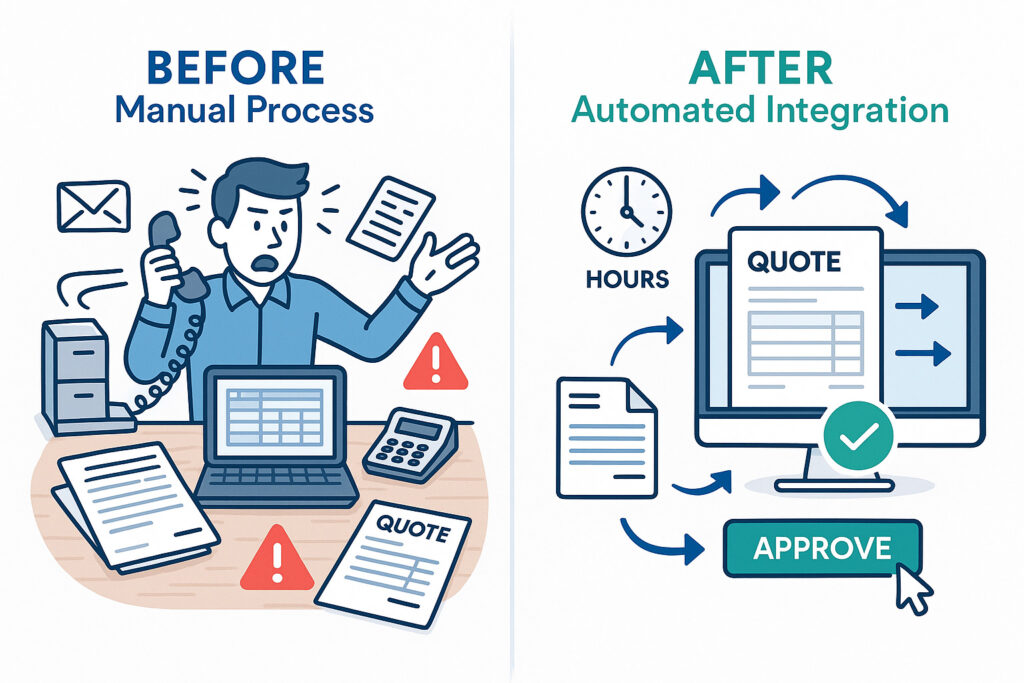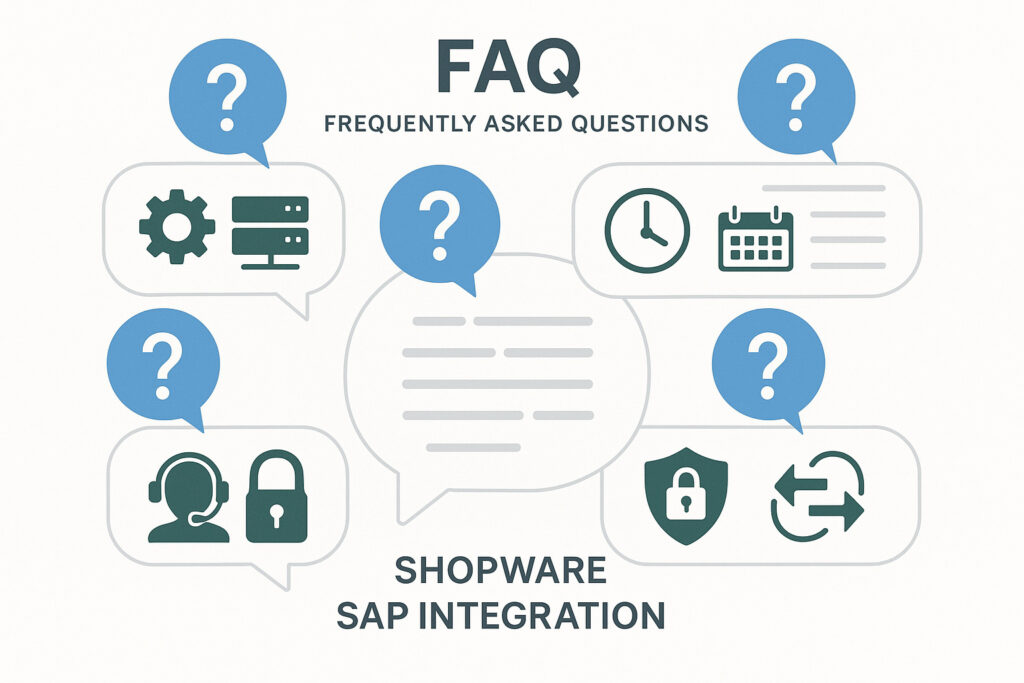If you’ve come to this blog, you’re either considering purchasing either Shopware or SAP, or both, and want to know how they work together, or you already have both solutions and are frustrated at how they don’t work together. Neither Shopware nor any of SAP’s products offer native integrations, which leaves businesses with two options: purchasing a third-party integration or developing a custom integration. Despite these difficulties, there are compelling use cases for integration, especially for those who already own both products. This guide to Shopware SAP integration discusses these use cases and benefits in further detail before providing advice on choosing an integration option.
What is a Shopware SAP Integration?

First, here is a quick explanation of what exactly we’re talking about here. Shopware is a popular, open-source eCommerce platform for both B2B and B2C. It’s one of the leading eCommerce solutions because of its flexibility, scalability, performance, and advanced security features. SAP is an ERP (Enterprise Resource Planning) platform that many businesses like due to its streamlined dashboards and powerful visibility tools. A Shopware SAP integration is a piece of software that enables the two solutions to connect and share data back and forth between them.
Why Integrate Shopware and SAP? 6 Use Cases and Benefits
| Use Case | Description |
|---|---|
| 1 . Business Process Automation | Automating key processes like PO generation, inventory updates, and shipping label creation to improve efficiency. |
| 2 . Enhanced Inventory Management | Automatic inventory syncing between the two systems reduces issues like overselling and inadequate stock. |
| 3 . Real-Time Data Analysis | Businesses can quickly respond to customer needs, discover trends and patterns, and gain insights into preferences. |
| 4 . Improved Supplier Management | Integration provides tools to track supplier performance, negotiate better prices, and automatically place orders. |
| 5 . Better Customer Experience | The integration provides self-service capabilities for customers to manage their ERP data and how it’s used. |
| 6 . Simplified Quotations | Syncing quotes between the two systems eliminates the need for manual, human-error-ridden workflows. |
Since you can’t just connect these two solutions out of the box and instead have to spend hundreds or thousands of dollars on an integration, you may wonder why you should even try integrating them in the first place. The truth is that both Shopware and SAP are very popular solutions that offer numerous benefits, particularly for B2B eCommerce companies, and you may not want to compromise on specific features by choosing other software that is easier to connect. Putting in the effort to integrate Shopware and SAP has numerous use cases and benefits, including:
1. Business Process Automation
A properly configured Shopware SAP integration automates order processing from quote to fulfillment, reducing manual intervention by up to 80%. Customer orders placed through your eCommerce platform automatically trigger corresponding sales orders in SAP, complete with accurate pricing, customer-specific terms, and inventory allocations.
Key automation benefits include:
- Order-to-cash acceleration: Purchase orders flow directly into SAP workflows without manual re-entry
- Pricing consistency: Complex B2B pricing rules from SAP (volume discounts, customer-specific rates, contract terms) apply automatically at checkout
- Approval workflows: Orders requiring internal approval route seamlessly through existing SAP authorization hierarchies
Manufacturing and distribution companies typically see 40-60% faster order processing times while eliminating costly data entry mistakes that plague manual systems.
2. Enhanced Inventory Management
SAP inventory data syncs continuously with your Shopware storefront, ensuring customers see accurate stock levels while preventing overselling scenarios. This real-time connection is particularly crucial for B2B merchants managing thousands of SKUs across multiple warehouses or drop-ship arrangements.
Advanced inventory capabilities include:
- Multi-location stock visibility: Customers view available quantities from their preferred fulfillment locations
- Reserved inventory handling: Items in SAP workflows (pending orders, quality holds) remain unavailable for new orders
- Automated reorder triggers: Low-stock alerts in Shopware align with SAP procurement cycles
B2B merchants using integrated inventory management report 25-35% fewer stockout situations and significantly improved customer satisfaction scores.
3. Real-Time Data Analysis
Integration consolidates eCommerce performance with traditional sales data in SAP, creating comprehensive dashboards that reveal true customer behavior patterns and business performance metrics.
Critical analytics improvements:
- Customer lifetime value tracking: Combine online and offline purchase history for accurate CLV calculations
- Channel performance comparison: Identify which products and customers perform better online versus through traditional sales channels
- Predictive inventory planning: Historical sales data from both systems improves demand forecasting accuracy

4. Improved Supplier Management
For B2B merchants offering drop-ship products or managing complex supplier networks, Shopware SAP integration extends visibility and control throughout the supply chain.
Supplier management enhancements include:
- Automated purchase order creation: Customer orders for drop-ship items automatically generate supplier POs in SAP
- Supplier performance tracking: Delivery times, quality metrics, and cost data aggregate for better vendor negotiations
- Three-way match automation: Receipts, invoices, and purchase orders reconcile automatically, reducing AP processing time
Distribution companies often achieve 30-40% faster supplier payment cycles while maintaining tighter control over procurement costs.
5. Better Customer Experience
Modern B2B customers demand the same digital experience quality they encounter in B2C environments. Shopware SAP integration enables sophisticated self-service features that reduce support burden while improving customer satisfaction.
Customer experience improvements:
- Account-specific catalogs: Customers see only products they’re authorized to purchase at their negotiated prices
- Order history and reordering: Complete purchase history from SAP displays in the customer portal, enabling one-click reorders
- Custom approval workflows: Large orders route through customer-defined approval processes before submission
B2B merchants typically see 50-60% reductions in order-related support calls while achieving higher customer retention rates.
6. Simplified Quotations
Complex B2B sales often begin with detailed quotation requests that require accurate pricing, availability checks, and approval workflows. Integration streamlines this traditionally cumbersome process.
Quote management benefits:
- Instant price calculations: Complex pricing rules, volume discounts, and customer-specific terms calculate automatically
- Real-time availability: Quote accuracy improves with live inventory and production capacity data
- Quote-to-order conversion: Approved quotes convert directly to sales orders without re-entry
Manufacturing companies that use integrated quotation systems typically reduce quote turnaround times from days to hours while improving quote-to-order conversion rates by 20-30%.

The strategic value of Shopware SAP integration extends beyond operational efficiency—it positions B2B merchants to compete effectively in an increasingly digital marketplace while maintaining the complex business rules and relationships that drive sustainable growth.
Choosing a Shopware SAP Integration Method
As we touched on earlier, there are two ways to connect your Shopware store to your SAP ERP. The first method is to purchase a ready-made integration, and hope that it provides all the functionality that you need – something that isn’t guaranteed. The second is to build your own custom integration. The first approach is relatively fast and simple, but it lacks flexibility and locks you into a third-party provider’s feature roadmap. Creating your own integration provides the ultimate flexibility and customization of features, but it obviously requires having staff on hand with the time and expertise to develop, which can be a problem.
However, you can strike a great balance for your business between the two methods by hiring an outside team to develop your custom integration. For example, Atwix can craft a custom-tailored Shopware SAP integration that meets your specific needs and solves your unique pain points. We’re often faster than in-house teams and have the experience to easily handle any hurdles that pop up during the integration process. We essentially give you the best of both worlds: the simplicity of an out-of-the-box solution and the flexibility and customization of a self-developed integration.

Frequently Asked Questions About Shopware SAP Integration
Reach out to consult with a Shopware SAP integration expert today.
What are the requirements for Shopware SAP integration?
There are crucial technical and operational prerequisites for a smooth integration between Shopware and SAP. These include:
Shopware Requirements
Shopware Version: Shopware 6.4 or higher
PHP Version: PHP 8.1 or compatible with Shopware 6 version
Database: MySQL 8.0 or MariaDB 10.4+
Web Server: Apache 2.4 or Nginx with HTTPS enabled
System Resources: Minimum 4 vCPU cores, 8 GB RAM
Admin Access: Access to the Shopware Admin panel
SAP Requirements
Version: SAP Business One version 9.3 or higher
Database: Microsoft SQL Server 2012 or higher, or SAP HANA database
Operating System: Windows Server 2012 or later, or Windows 10 for client installations
Integration Framework: SAP Business One Integration Framework (B1if)
User Access: Proper user permissions for API access and data manipulation
Network: Stable and secure connection between SAP and Shopware
How long does a Shopware SAP integration typically take to implement?
Most Shopware SAP integrations are completed within 8-12 weeks, depending on your existing SAP configuration and business complexity. Atwix’s pre-built integration framework can accelerate this timeline by up to 40% compared to fully custom solutions. The process includes discovery, development, testing, and go-live phases with weekly progress updates throughout.
Can we maintain real-time synchronization between Shopware and SAP?
Yes, real-time data synchronization is achievable and recommended. Inventory levels, pricing updates, order status changes, and customer information sync instantly between systems. This eliminates overselling, pricing discrepancies, and manual data entry errors that can cost B2B businesses thousands in lost revenue.
Which SAP modules can be integrated with Shopware?
All core SAP modules integrate seamlessly, including SAP ECC, S/4HANA, Business One, and ByDesign. The integration covers inventory management, order processing, customer data, pricing engines, product catalogs, and financial reporting. Custom workflows and specialized modules can also be accommodated based on your business requirements.
What happens to our existing data during the integration process?
Your existing data remains completely secure with zero risk of loss. The integration process includes comprehensive data mapping, validation testing, and full system backups before any migration begins. All development occurs in staging environments with rollback procedures in place, ensuring your current operations continue uninterrupted.
How much technical disruption should we expect during implementation?
Minimal disruption is guaranteed through parallel development environments and off-hours implementation scheduling. Your current Shopware and SAP operations continue normally during development and testing. The final system switchover typically requires only 2-4 hours of planned downtime, scheduled during your lowest traffic periods.
